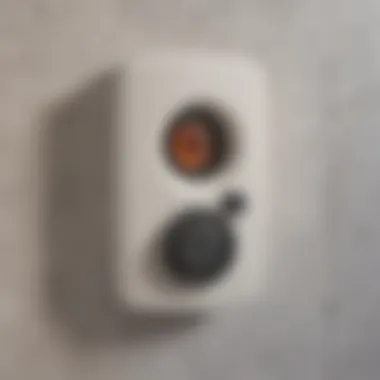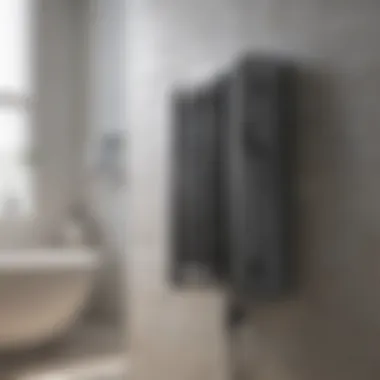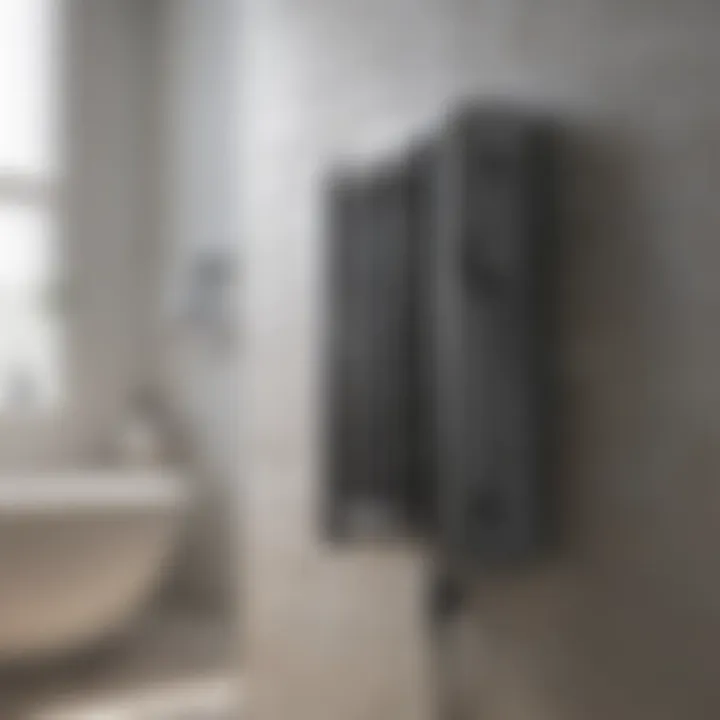Exploring Bathroom Heaters: Essential Guide for Homeowners


Intro
During colder months, a bathroom can quickly become uncomfortable. To ensure warmth and coziness, bathroom heaters present a practical solution. In this guide, we will thoroughly explore options available at Home Depot.
Caring for your comfort and enhancing your home's energy efficiency are important elements every homeowner should consider. Factors like the types of heaters, installation methods, and ongoing maintenance can affect your heating experience. This will allow residents to choose a suitable heating option tailored to their personal preferences.
Let us begin laying the groundwork for our project.
Materials:
Choosing the right materials is essential when installing a bathroom heater. Below is a detailed list:
- Bathroom Heater: Choose based on size and power required (e.g., a 1500-watt model for a standard bathroom).
- Electrical Wire: 12-gauge stranded wire, approximately 50 to 75 feet.
- Electrical Box: One size suitable for the heater setup.
- Heater Circuit Breaker: Appropriate size, typically 20-amp.
- Wall or Ceiling Mounted Brackets: As required per heater installation.
- Screws and Anchors: These should match the brackets; usually around 8 total.
- Wire Nuts: Approximately 5-6 for securing electrical connections.
- Tape Measure: Required for accurate placements.
- level tool: To ensure proper alignment during installation.
- Screwdriver (Phillips or flathead as needed).
- Safety goggles: Essential for personal safety during installation.
- Electrical tape: Protective wrapping for exposed wires.
- Drill: Necessary for creating holes for screws and anchors.
DIY Steps
The installation of a bathroom heater involves a structured workflow to optimize effectiveness. Follow these steps carefully.
- Plan the Location: Decide where the heater will be mounted, considering exposure to moisture and distance from water sources.
- Turn Off the Power: Before commencing the installation, ensure that the circuit to the designated area is turned off at the breaker box.
- Prepare the Area: Remove any existing fixtures and clear the area of obstacles.
- Install the Electrical Box: Secure the box at the selected height. Ensure it is firmly anchored.
- Run the Electrical Wire: Use your tape measure to determine proper lengths. Route the wire from the electrical box to a power source, abiding by local codes.
- Connect Wire to Heater: After running the wire, make sure to connect it according to the manufacturer's instructions. Typically, match color-coded wires: black to black, white to white, and protect connections with wire nuts.
- Attach the Heater: Using the mounting brackets, fix the heater unit to the wall or ceiling, ensuring it fits securely.
- Final Assembly: Secure screws and check everything is tightly fastened and safe.
- Restore Power: Finally, switch the circuit back on and test the heater.
Technical Aspects
To aid in installation and build quality, consider the following technical elements.
Tools Needed:
- Screwdriver (about 8-inch)
- Drill (with appropriate bits)
- Wire Strippers (for preparing electrical wire)
Timing Specifics:
- The installation typically takes 3-4 hours from start to finish.
Key Techniques:
- Ensure all connections are tight. Air leaks can reduce heating efficiency.
- Follow specific manufacturer's instructions for wire connections to avoid default issues.
DIY project Process
Once all materials are gathered and the steps outlined, follow this sequential project process:
- Follow the planning process.
- Execute the DIY steps mentioned above carefully.
- Confirm connections by spotting any exposed wires not secured with tape or nuts.
Troubleshooting Tips:
If the heater does not work after installation, check the circuit breaker and any disconnections in wiring. Ensure all identified safety precautions were adhered to during assembly.
With everything in place and working seamlessly, relaxing warmth will be enjoyed in your bathroom for the duration of the season.
Preamble to Bathroom Heaters
Understanding bathroom heaters is critical for homeowners, especially in regions with cold weather. This introduction sets the stage for exploring why bathroom heaters are essential in creating a comfortable living space.
Definition and Purpose
Bathroom heaters are devices specifically designed to warm bathrooms. They come in various forms, such as electric and infrared heaters. The primary purpose of these heaters is to reduce the chill one feels when stepping into the bathroom. Many people find discomfort in cold bathrooms, which can lead to negative experiences.
Apart from comfort, bathroom heaters also assist in preventing moisture buildup. This is especially helpful during colder months when bathers tend to close windows and doors, leading to an excess of humidity. Ultimately, having a bathroom heater enhances the usability of this essential space in the home, making daily routines more pleasant.
Importance of Heating in Bathrooms
Heating bathrooms is not just about comfort. It serves multiple purposes that contribute to both health and maintenance. Warm bathrooms prevent sudden temperature changes, which can be harmful especially for those with sensitivity to cold. It is also vital for reducing humidity, leading to lower risks of mold growth.
- Health and Comfort
Warm air circulates throughout the bathroom promoting a more inviting environment. - Maintenance of Bathroom Furnishings
Consistent heating protects walls, tiles, and other materials from moisture damage. - Usage Frequency
An adequately heated space encourages family members to use the bathroom facilities more frequently.
Having a reliable heating solution in your bathroom not only enhances individual comfort but fosters an environment that is healthier for the entire household.
In summary, bathroom heaters offer significant advantages in enhancing overall comfort and ensuring the bathroom remains functional year-round. Being aware of these benefits arms homeowners with vital information to make informed decisions, ensuring their bathing experience is always pleasant.
Types of Bathroom Heaters
Understanding the various types of bathroom heaters is vital for homeowners aiming to enhance comfort in their bathrooms. With a myriad of options available, it is crucial to analyze each type’s specific features, benefits, and considerations. This knowledge will ensure that selections are not only suited to individual needs but also aligned with overall home efficiency and safety.


Electric Heaters
Electric heaters are perhaps the most prevalent option in bathrooms. They use electrical resistance to generate heat quickly, making them suitable for small spaces. Homeowners often choose these heaters for their straightforward installation and the absence of complex ductwork.
Benefits
Electric heaters offer the ability to warm a room in a matter of minutes. They tend to be more energy-efficient than other options, especially when only the bathroom requires heating during colder times.
Considerations
However, operating expenses should be evaluated closely. Electric fees can vary dramatically. Some models, especially baseboard and wall-mounted units, may allow more space than others but could draw more power. Overall, the choice of model should fit the specific requirements of the room in context.
Infrared Heaters
Infrared heaters are less common but gaining traction among homeowners who seek targeted heat. These units operate differently than traditional heaters, emitting infrared waves that directly warm people and objects in the room without heating the air itself significantly.
Benefits
Infrared heaters provide comfortable heat within moments. They are generally silent and energy-efficient, warmer directly and wasting less energy on heating the air. Because they focus on radiant heating, they are also beneficial for households with insulation issues, where maintaining air temperature can be problematic.
Considerations
On the downside, infrared heaters may not efficiently heat larger bathrooms, as their effectiveness is limited to direct lines of sight. Positioning the unit properly will play a crucial role in maximizing efficiency. If an infrared heater is anticipated for versatility, size guide for usage space should not be neglected.
Wall-Mounted vs.
Portable Heaters
Deciding between wall-mounted and portable heaters can affect both space design and usage flexibility. Each style serves its purpose effectively and can be suited for various needs.
Wall-Mounted Heaters
These heaters are fixed and take up minimal floor space, ideal for smaller bathrooms. They provide a permanent solution for heating space, creating a clutter-free aesthetic.
Portable Heaters
Conversely, portable heaters offer flexibility, allowing movement from one room to another. Homeowners can heat the bathroom before usage and then relocate them to other parts of the house as needed.
Key Insight: The choice between wall-mounted versus portable heaters largely depends on individual space management preferences and heating requirements throughout the home.
The End
When examining electric, infrared, wall-mounted, and portable heaters, understanding their unique characteristics helps in making a more informed decision. Selecting the right type may depend on factors such as bathroom size, frequency of use, and desired heating effectiveness.
Key Features to Consider
When selecting a bathroom heater, certain features should not be overlooked. These elements can significantly influence the efficiency and safety of the heater. Choosing wisely ensures a comfortable and economical heating experience in your space. We'll delve into several key features that are essential for any homeowner, enabling you to make informed choices for your bathroom heating needs.
Energy Efficiency
Energy efficiency is a primary consideration for any heating system. Bathrooms are generally small spaces, so choosing an energy-efficient heater can save you significant costs on energy bills. An energy-efficient heater consumes less power for the same level of heat output. When browsing at places like Home Depot, look for heaters boasting high energy ratings. Products with such certifications not only reduce your carbon footprint but may also qualify for rebates or incentives offered by local governments. This investment contributes long-term value to the household.
Safety Features
Overheat Protection
Overheat protection systems in bathroom heaters play a critical role in preventing fires. These devices automatically shut off the heater if it reaches a dangerously high temperature. This particular safety feature ensures peace of mind for homeowners, especially if using the heater in moist and sometimes unsupervised environments. Often, heaters with overheat protection are popular because they comply with strict safety standards. As a result, consumers see these models as durable and reliable for long-term use.
Splash Resistance
Splash resistance is another important safety characteristic. Given that bathrooms regularly expose heaters to moisture, selecting a splash-resistant model reduces the risk of water-related electrical issues. A splash-resistant heater will have enclosure ratings that keep it safe against the occasional droplets or splashes of water present. However, it is crucial to understand that not all heaters are designed the same. Thus, thoroughly reviewing the product details and guarantees will help you avoid potential pitfalls in this respect.
Adjustable Thermostats
Heaters with adjustable thermostats offer more than simple temperature control; they introduce comfort that adapts to your lifestyle. By allowing you to set the desired level of warmth in your bathroom, a user-friendly thermostat can optimize energy use. Homeowners gain significantly, as a tailor-made temperature curtails extreme fluctuations. Users have commented positively about models with digital thermostats that display the current temperature, providing precise control over their environment, further enhancing the product's appeal.
Key takeaway: A well-featured bathroom heater caters directly to both comfort and safety while allowing users to maintain significant control over energy costs. Considering each feature facilitates reaching an informed decision, leading to a better investment in your home.
Benefits of Using a Bathroom Heater
Bathroom heaters play a significant role in enhancing comfort in home environments. When considering the chilly mornings or the cold drafts typically found in bathrooms, a heater becomes an essential appliance. The benefits extend well beyond mere warmth. Homeowners appreciate how a bathroom heater can significantly improve their overall bathroom experience. This section elucidates the reasons why opting for a bathroom heater can foster not only a more pleasant environment but also residual advantages across the entire home.


Enhanced Comfort
A primary benefit of using a bathroom heater is enhanced comfort. Stepping into a warm bathroom early in the morning or late at night is a luxury that many homeowners cherish. The feeling of warmth directly relates to comfort levels and reduces stress. Having consistent warmth mitigates the chilliness that can make a bathroom unwelcoming. Heaters create an inviting atmosphere, especially for families with younger children or elderly members who may be more sensitive to cold.
Moreover, higher comfort levels also facilitate daily routines. When the environment is more pleasant, it leads to quicker hygiene routines. A cozy setting helps engage in longer, more relaxed baths or showers, contributing to better personal time and well-being. Ultimately, homeowners discover that enhanced comfort signifies quality of life improvement.
Reduced Humidity and Mold Growth
Bathrooms are naturally damp areas, which can lead to the growth of mold and mildew. This is a prevalent issue, especially in seasons with increased moisture. However, using a bathroom heater can effectively address this concern. Heating the bathroom reduces humidity levels, which limits moisture retention. As humidity dissipates, the potential for mold to take root diminishes significantly.
It's essential to note that mold poses health risks, making moisture control critical. The airborne spores can trigger allergies and respiratory problems, impacting overall health when left unchecked. Thus, utilizing heating solutions not only saves the aesthetics of the bathroom but also maintains a healthier home environment.
Energy Savings in Home Heating
Investing in a bathroom heater can contribute to energy efficiency as well. While it may seem counterintuitive, having a designated heating source for small areas can lead to actionable energy savings. Instead of heating the entire home to get the bathroom warm, which can be inefficient, space heaters operate individually and allow for temperature control within specific zones.
This aspect can also be financially beneficial. Homeowners may notice a reduction in utility bills by maintaining different temperatures tailored to various spaces in the house. A bathroom heater's efficient heating system can leave larger household heating systems functioning more economically. Customers often characterize this maneuver as realizing more value from their savings.
The cost-effective benefits from utilizing targeted heating solutions can lead to significant annual savings in energy bills.
Choosing a bathroom heater indeed renders multiple undeniable advantages that lead to improved comfort, better health, and enhanced efficiency in energy expense management.
Where to Buy Bathroom Heaters
Finding the right location to purchase a bathroom heater is crucial for homeowners. An informed choice can significantly impact the overall comfort and utility of this installation. Choosing between retail options involves assessing factors such as product availability, pricing, and support services. Both physical stores and online platforms have their unique advantages, making it essential to explore all available avenues before making a decision.
Home Depot: A Reliable Option
Home Depot has positioned itself as a trusted resource for bathroom heaters. Known for its broad assortment, the selections often span various brands and models. Benefits of shopping at Home Depot include:
- In-store Expertise: Knowledgeable staff can assist in selecting appropriate models based on individual needs and home specifications.
- Product Range: You'll find a variety of options from electric heaters to infrared choices, catering to diverse preferences.
- Price Matching: Home Depot often offers competitive pricing and may match lower prices from other retailers.
Moreover, it's possible to view heating units in person, allowing for immediate evaluation of size and design. If purchasing online, the convenience of home delivery adds to its appeal.
Online Retailers and Local Stores
The appeal of online shopping for bathroom heaters cannot be overlooked. Online retailers offer wide selections that may not be available locally. Here are some things to consider when using online platforms:
- Convenience: Shop from home at any time and compare numerous models more freely.
- Customer Reviews: Access to feedback from previous buyers can give insights into product performance and reliability.
- Delivery Options: Many retailers offer affordable or even free shipping options.
Conversely, local stores may yield benefits like direct interaction. Facing issues or inquiries can be promptly addressed in person. Small, specialized shops may offer unique models not found in big-box chains, making them worthy alternatives.
Ultimately, whether choosing a well-known retailer like Home Depot or exploring the depths of online marketplaces, understanding the pros and cons helps make an informed electronic purchase decision.
Installation Tips
Installing bathroom heaters requires careful planning. An improper initation can lead to safety hazards, ineffectiveness, or even damage to the heater. Being aware of the right installation methods is cruial for maximizing the benefits of a bathroom heater. Key areas of focus should include the location selection, electrical requirements, and adherence to safety regulations. Proper installation ultimately affects energy efficiency and longevity of the unit.
DIY Installation
Many homeowners consider DIY installation of bathroom heaters due to potential cost savings. When opting for a DIY approach, accurate assessments and planning are essential. Start with identifying the best location for the heater; it should ideally be near a power source and away from direct water sources.
Before purchasing, ensure that you familiarize yourself with the specific installation guidelines that accompany your chosen heater. Taking this step ensures compliance with essential safety standards. Furthermore, pay attention to electrical specifications. Most heaters require a standard outlet, but certain models may need dedicated circuits, especially more powerful units.
- Gather the right tools: You will typically need a drill, screwdrivers, a stud finder, and possibly wire strippers.
- Follow the manufacturer’s Instructions: Every heater comes with an installation manual that lists necessary safety precautions. Don’t skip this key step.
- Validate Current Wiring: Before attaching anything, check your home’s wiring to assess whether it suits the heater’s requirements.
Despite the benefits of DIY installation, one must feel confident in handling basic electrical work to ensure homeowner safety.
Always turn off the power at the circuit breaker before starting your work to avoid unwanted signs of electrical fault while installing your bathroom heater.
Professional Installation Services
Choosing professional installation services can relieve the stress tied to DIY setups. An experienced technician carries the knowledge to quickly manage potential concerns, ultimately resulting in a secure and operational heater installation without hassle. They know local building codes and standards, which minimizes any regulatory issues that could arise following installation either.
When considering professional services:
- Assess Qualifications: Ensure that the technician has experience with bathroom heaters and electrical installations. Always inquire about credentials.
- Requesting Quotes: Pricing can vary, based on the complexity of the installation. Thouroughly detailed quotes provide clarity concerning costs.
- **Warranty: ** Check if the installation warranty is included, providing peace of mind about workmanship.
This approach reduces subsequent risks associated with electrical fire hazards – a significant concern in wet environments like bathrooms. Selecting the right installation method, whether DIY or by hiring professionals, requires understanding laymen and the potential challenges involved.
Maintenance and Care


Maintaining and caring for your bathroom heater is fundamental to ensuring its longevity and efficiency. A well-maintained heater offers optimal performance, low energy costs, and blueur soor comfort during cold wkeather. Neglecting this maintenance can lead to decreased heat output and an increase in energy consumption, making it essential to prioritze this aspect of home ownership.
Regular inspections and cleaning serve not only to uphold appliance effectiveness but also to prevent hazards like faulty wiring or dust accumulation. Homeowners benefit greatly from being proactive in caring for their units. This is particularly true in a damp environment like a bathroom, where excess moisture can impact heater functionality.
Regular Cleaning and Inspection
Regular cleaning is th ecornerstone of effective bathroom heater maintenance. Dust and debris can collect on the heater's exterior and in vents, leading to blocked airflow. Loss of airflow negatively affects the entire heating system, resulting in inefficiency.
- How to Clean Your Heater:
- Turn Off Power: Before any cleaning, make sure the device is powered down and cool.
- Inspect: Look for any signs of wear, tear or damage during your initial inspection.
- Dusting: Use a soft cloth to wipe down the surface. A damp cloth can be utilized for stubborn stains, but ensure water does not get inside.
- Check Vents: Clear any obstructions in vents and grilles.
Perform these cleaning routines bi-weekly in peak usage seasons. Ensuring that any quickly expiring life remains short prevents larger malfunctions.
Troubleshooting Common Issues
Even with proper care, issues can arise with bathroom heaters. It is en, this is where understanding how to troubleshoot can greatly enhance usage.
Heating Malfunction
Heating malfunctions might occur when a heater fails to warm the bathroom adequately. This issue relates to worn geographical locations, dog activities, temperature differences or improper initial installation. A vital characteristic of heating malfunction is the lack of consistent temperature; if the unit clicks in consistently or behaves unpredictable, investigating is essential.
Identifying common causes, such as faulty thermostats, damaged wiring, or inadequate power supply is crucial. Electrical problems or tripping circuit breakers may also signal an issue that warrants thorough inspection of the heater.
One single trick for resolving minor failures is modifying the thermostat setting. Getting it rematched consistently allevitates heating output concerns for centered indications or physical movements. Ensuring correct configuration results in homeowner's ease and is known to ring well in buyer interviews.
Noise Issues
Noise issues are represented by louder than expected operation, which might involve buzzing or rattling sounds during heater usage. During times of intensive operation, noise sometimes magnifies everything; it's indicative of parts expansion. Most homeowners agree that a quiet space adds to the overall comfort and appeal of the bathroom experience.
Various factors could contribute to these noises. It could arise from loose panels, metal contraction, or even debris obstructing parts in fan-driven heaters. Frequently, tightening screws or ofheat diminishers resolves noise complaints at their core.
From homeowner experience, excessive token feedback annoying is often tied to imperfections san, radiate, or trauma approaching despair. Being conscious of reasonable expectations can inform buying prioritiy.
Regular maintenance, including cleaning and troubleshooting, is a proactive measure that can increase your bathroom heater's lifespan, reduce repair costs, and ensure efficient operation.
Energy Efficiency and Cost Considerations
Energy efficiency plays a crucial role in selecting bathroom heaters. Homeowners must not only assess the initial investment in a heater but also evaluate the long-term operating costs. Choosing an energy-efficient heater can significantly lower monthly energy bills while providing ample warmth during winter months.
Considering cost implications helps homeowners make wiser decisions and can contribute to reduced environmental impact through lower energy usage. Here, we analyze both initial purchase costs and ongoing operating expenses, underscoring their importance in the overall value of a bathroom heater.
Initial Purchase Costs
After recognizing the significance of energy efficiency, homeowners can explore initial purchase costs. The price varies widely among different heater types and brands. For instance, electric heaters tend to be more affordable at first compared to infrared heaters, which often have higher upfront costs due to advanced technology.
Several factors influence the initial purchase costs, including the model’s features. A heater with additional safety features or enhanced designs might come with extra expense. Additionally, homeowners should consider potential installation costs if opting for wall-mounted models, since they may need to hire a qualified technician. Thus, careful budget planning can lead to a more prudent choice that aligns long-term goals with immediate capabilities.
When considering budget, remember: sometimes spending a little more on energy efficient units can save you significantly in the long run.
Operating Costs and Savings
While much attention is given to purchase prices, operating costs often go overlooked. The underlying electricity prices, efficiency ratings, and frequency of use can dramatically affect ongoing expenses. For example, a heater with a higher energy star rating usually consumes less energy, reducing utility bills.
Over time, the savings can amount to a substantial sum, which makes diligent calculation vital. It is important to monitor energy consumption skyrocketing during colder months when bathroom usage increae and heaters are working regularly. Understanding one's usage habits can also guide in setting an optimal heating schedule, balancing comfort with efficiency.
Ultimately, considering the operating costs alongside the initial purchase costs delivers a well-rounded perspective that benefits both homeowners’ budgets and the environment.
The End
The conclusion of this article holds significant weight for homeowners considering the purchase and use of a bathroom heater. Wrapping up the discussion of bathroom heaters is a moment to reflect on crucial factors such as energy efficiency, practicality, safety, and overall comfort. These heaters are no longer just a fleeting convenience during winter; they can prove invaluable in maintaining a pleasant bathing environment.
Homeowners must realize that the choice and proper usage of bathroom heaters carry implications that affect both the environment and household energy consumption. Utilities bills can drag down savings; therefore, selecting an energy-efficient model can translate to noteworthy savings over time.
In summary, reviewing all of the insights discussed in previous sections can help in making an informed purchase, aligning heater choice with personal and household needs. Moreover, given the liabilities usually posted from neglecting safety standards, attention to automatic shut-off features and other protective elements becomes essential.
“Heating may not be the heart of a home, but a bathroom heater is definitely its comfort zone.”
Summary of Key Points
- Recognition of different types of heaters available.
- Importance of energy efficiency to reduce costs.
- Need for safety features to prevent accidents.
- Potential benefits on humidity control and overall comfort.
- Emphasis on correct installation and regular maintenance to ensure durability.
- Final thought: opting for reliable brands like those available at Home Depot can assure quality.
Final Recommendations
- Assess heat needs based on bath and home dimensions.
- Prioritize energy-efficient models: this will reduce long-term bills.
- Choose installations that suit your style—for instance, wall-mounted versus portable variants can affect usability and decor.
- Don’t overlook safety—always verify that features like overheat protection and splash-proof designs are integrated prior to making a choice.
- Regular maintenance checks will extend the life of your heater and optimize its efficiency.
- Explore reputable retailers, such as Home Depot, to ensure quality and better customer support.
Ultimately, making an informed decision on the correct bathroom heater transforms the bathing experience, ensuring it is not just warm but also safe and efficient.







